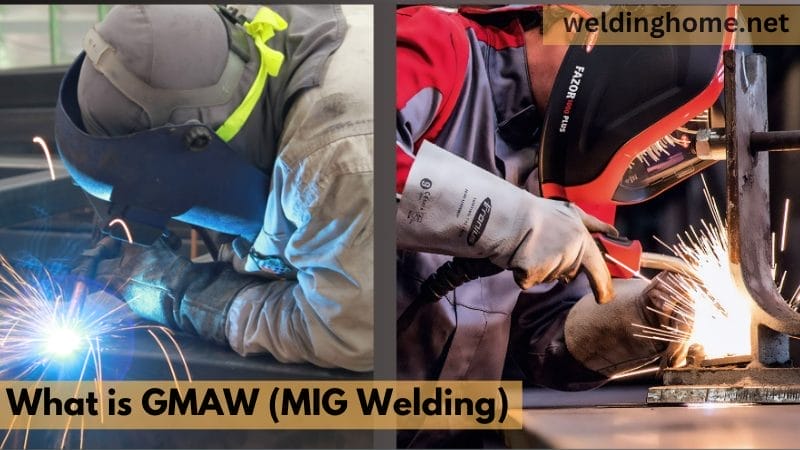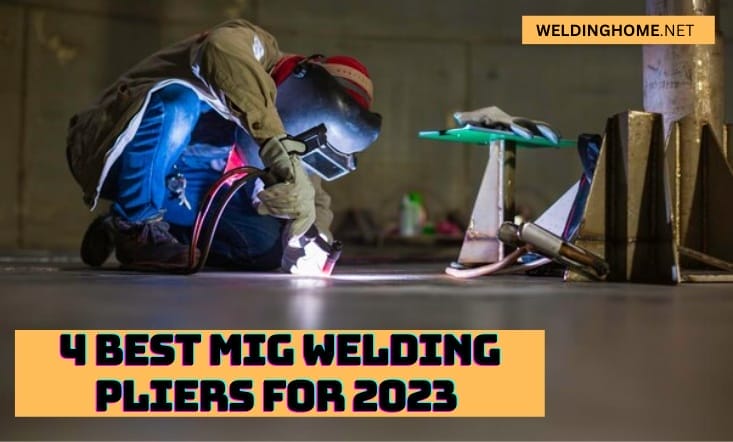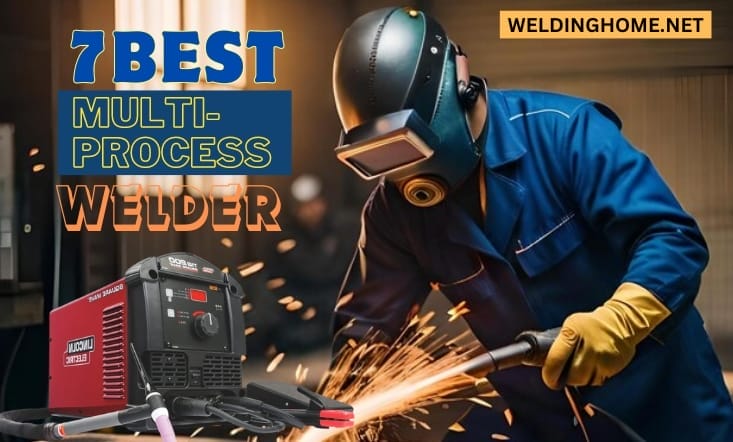What is GMAW (MIG Welding), and how Does it Work?

Gas Metal Arc Welding, or GMAW, also known as MIG welding, is one of the most essential techniques in the world of welding. For those who don’t know, the name hides an exciting process that quickly joins metals together.GMAW stands for “mig welding.
“What is GMAW (MIG Welding)? How does work? Let’s take this fantastic welding job apart. At its core, GMAW uses a protective gas, a welding machine, and a continuous solid wire electrode to join metals without any gaps.
As I start this journey, I’ll look into the complicated dance of the welding machine, the role of protecting gas, and how the electrode wire is fed. Learning the ins and outs of GMAW is more than just a technical journey; it’s a gateway to a world where art and skill meet.
Come with us as we take the mystery out of GMAW by showing you how its parts work and the steps that make it an essential skill in the world of welding.

How Does MIG Welding Work
MIG Welding Basics
- MIG welding involves the automatic feed of an electrically charged, solid wire into the weld joint at a set speed.
- The molten pool is shielded by supplied gas during the welding process.
Power Source and Arc Generation
- The power source in the welder energizes the wire, initiating and driving the welding arc.
Electrode Polarity
- GMAW always utilizes a direct current electrode positive (“DCEP”) polarity.
- The ground clamp attaches to the negative terminal, while the MIG torch connects to the positive terminal.
Arc Initiation
- Attaching the ground clamp to the welded piece and triggering the MIG torch creates an arc.
- The arc forms as the wire contacts the grounded metal, closing and shorting the electrical circuit.
Heat Generation and Wire Melting
- The arc quickly generates heat, causing the wire at the tip to melt along with a thin part of the base metal.
- The wire feeder continuously pushes a solid wire into the joint, creating another short circuit.
Continuous Short Circuit
- Shorting the circuit and melting the wire tip occurs rapidly, resulting in spatter, sparks, and the distinctive MIG sizzling sound, akin to bacon frying in a pan.
Role of the Wire as Electrode and Filler Material
- The wire acts as both an electrode and filler metal material in the MIG process.
- MIG welding necessitates the use of filler material to create an arc and deposit metal into the joint.
Metal Transfer Modes
- Short-circuiting, globular, spray, and pulsed spray are the four primary methods of metal transfer in GMAW.
- The transfer mode depends on factors such as wire feed speed, voltage setting, and shielding gas.
Components of GMAW
To comprehend GMAW fully, one must be familiar with its core components:
Welding machine
The welding machine powers the entire process, providing the necessary voltage and current to create the arc.
Shielding gas
Shielding gas, often a mix of argon and carbon dioxide, protects the weld from atmospheric contaminants, ensuring a clean and stable welding environment.
Electrode wire
The consumable electrode wire is continuously fed through the welding gun, serving as both filler material and electrode.
Pros of MIG Welding:
- MIG welding is the most straightforward arc welding process to learn, making it accessible for beginners.
- The equipment for MIG welding is relatively inexpensive, providing a cost-effective option.
- MIG welding boasts high speed and productivity, making it efficient for various projects.
- It offers an excellent metal deposition rate, ensuring efficient welding.
- Compatible with commonly welded metals, MIG welding is versatile for diverse applications.
- Weld appearance in MIG welding is often superior to stick welding, enhancing the overall finish.
- Supports multiple metal transfer modes, including the advanced pulsed MIG welding.
- MIG welding can effectively weld thin sheet metal, expanding its application range.
- Provides deep penetration for thick materials, ensuring solid and durable welds.
- Generates lower spatter, sparks, and smoke compared to stick welding, contributing to a cleaner work environment.
- MIG welding is a well-established process with abundant experience and information available.
- No slag is produced, minimizing post-weld cleaning efforts.
- Works well as a low hydrogen alternative to stick welding, enhancing safety.
Cons of MIG Welding:
- Produces more spatter, sparks, and smoke compared to TIG welding.
- It is not suitable for outdoor use in windy conditions as the shielding gas can blow away.
- The resulting weld appearance may not be as aesthetically pleasing as TIG welds.
- Requires frequent replacement of consumables, increasing operational costs.
- Often demands additional, costly equipment like spool guns or push-pull systems.
- Offers fewer functions for arc control compared to TIG welding.
- Welding aluminum with a spool gun can be limiting, affecting wire costs and reloading frequency.
- The MIG gun’s size can make it challenging to use in hard-to-access corners.
Where Is MIG Welding Used?
MIG welding, or Gas Metal Arc Welding (GMAW), finds extensive application across various industries due to its versatility and efficiency. Here are some key areas where MIG welding is commonly used:
- Automotive Industry:
- MIG welding is widely employed in the automotive sector for manufacturing and repairing vehicle components. It ensures robust and reliable welds, contributing to the structural integrity of vehicles.
- Construction:
- In the construction industry, MIG welding is used for structural welding, connecting metal components, and ensuring the stability of buildings and infrastructure.
- Fabrication Shops:
- Fabrication shops utilize MIG welding for creating metal structures and components. Its speed and efficiency make it suitable for high-volume production.
- Shipbuilding:
- MIG welding is prevalent in shipbuilding, where it is employed to join metal plates and components, contributing to the construction of ships and marine structures.
- Manufacturing:
- Various manufacturing processes leverage MIG welding for assembling metal parts, providing a quick and reliable method for joining materials.
- Repair and Maintenance:
- MIG welding is commonly used in repair and maintenance work across industries. It is versatile enough to repair everything from household items to heavy machinery.
- Aerospace Industry:
- In the aerospace sector, MIG welding is utilized for welding components of aircraft and spacecraft. Its precision and reliability are crucial in this highly specialized field.
- Energy Sector:
- MIG welding plays a role in the energy sector, contributing to the construction and maintenance of pipelines, power plants, and other energy-related infrastructure.
- Metal Furniture Manufacturing:
- The metal furniture industry utilizes MIG welding to create sturdy and durable furniture pieces. Its ability to weld various metals makes it suitable for diverse design requirements.
- Artistic Welding:
- MIG welding is also employed in artistic applications, where welders use their skills to create sculptures, metal art, and other decorative pieces.
- DIY Projects:
- MIG welding has become popular among DIY enthusiasts for various home projects. Its relative ease of use makes it accessible for individuals looking to tackle their welding tasks.
In essence, MIG welding’s broad applicability makes it a go-to choice in industries where a reliable, efficient, and versatile welding method is essential.
Tips for Successful GMAW
Proper setup and equipment maintenance
Ensuring the welding machine is calibrated correctly and the equipment is well-maintained contributes to successful GMAW.
Technique and control
Mastering the art of controlling the welding gun and adjusting parameters is vital for achieving high-quality GMAW results.
Equipment Needed for MIG Welding:
- A MIG welder is the main tool, providing a constant voltage power source. Ensure it has an integrated wire feeder. Hobbyist-grade welders usually have the wire feeder built in.
- The MIG gun comes with the welding machine and is essential for feeding the welding wire. Check its duty cycle rating, aiming for a minimum of 60% for the amperage range.
- Acquire a shielding gas tank, which can be purchased or rented. Buying is often a better option for convenience. Different shielding gases suit various welding applications.
- Use a dual-gauge dial regulator for controlling the flow of shielding gas. Flowmeter regulators are an alternative, offering better readability and reliability.
- For gas-shielded arc welding, you need a solid MIG wire. Some MIG units can also use flux-cored wire for a different welding process that doesn’t require shielding gas.
- Wear an auto-darkening welding helmet for ease and comfort during welding. It automatically adjusts to the brightness of the welding arc.
- Never use regular sneakers for welding. Invest in certified welding boots to protect your feet from molten debris. Boots with metatarsal guards offer additional protection.
- Get a pair of sturdy leather gloves to protect your hands from spatter and heat during MIG welding. Heavy-duty gloves provide added safety.
MIG welding requires a set of essential tools and safety equipment to ensure a smooth and secure welding experience.
Safety Precautions in GMAW
- Welders must wear appropriate protective gear, including helmets, gloves, and clothing, to ensure safety during the welding process.
- Adequate ventilation and fume extraction systems are essential to prevent inhalation of welding fumes, promoting a safe working environment.
Conclusion
MIG welding is a flexible and accessible welding technology with many industrial applications. MIG welding may be learned for numerous jobs with the correct equipment, including the MIG welder, gun, shielding gas tank, and other tools.
MIG welding’s high speed, productivity, and metal deposition rates make it popular in fabrication shops, automobile production, and more. Its smooth weld look, support for numerous metal transfer techniques, and ability to deal with commonly welded metals solidify its welding position.
MIG welding has benefits, including cost-effectiveness and minimum post-weld cleaning, but it also has drawbacks. Consider higher spatter and frequent consumable refills when considering MIG welding for specific tasks.
A good welder may use MIG welding to build buildings, repair cars, and undertake DIY projects with creativity and accuracy. As technology progresses, MIG welding procedures will improve, making it fascinating for beginners and experts.
MIG welding is a fundamental technology that bridges the gap between efficiency and quality welds. With the correct skills and equipment, welders can make robust and durable metalworking connections. So prepare, enjoy the flames, and let MIG welding open your life to unlimited possibilities.
FAQs
Is GMAW suitable for all types of metals?
GMAW is versatile and can be applied to various metals, including carbon steel, stainless steel, and aluminum.
What is the main advantage of GMAW over other welding processes?
GMAW is known for its speed and efficiency, making it ideal for high-production welding.
How can I avoid excessive spatter in GMAW?
Fine-tuning welding parameters, such as voltage and wire speed, helps reduce excessive spatter.






